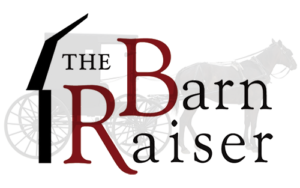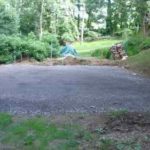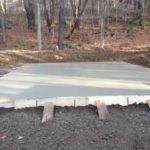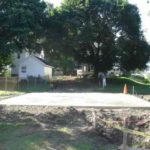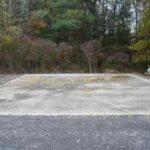Site Preparation
The customer is responsible for any site preparation, site accessibility* and permits needed for the structure. Permit requirements vary from town to town. Please check with YOUR town building department for info on permits, foundation requirements, etc. What you read below are general recommendations and common site preparation in our area. However; you may need to do something entirely different to meet YOUR code. Please make sure to tell them that this is a pre-fabricated structure and we are delivering it to you either whole or in two sections depending on what you order. Our company does not build the structure on-site but our modular structures do require on-site finishing work. It is usually helpful for you to bring in one of our brochures, so that you can show them the product. You may even be asked to submit architectural drawings. We have professional drawings available for every one of our buildings. If you have not purchased a building yet, we charge $25 for a set of prototype drawings, and we refund that fee back to you upon order. If you need NYS stamped plans showing your specific layout, your name, address, etc., they are available for a non-refundable fee and they generally take 7-10 days to receive.
First, choose a site accessible to a full-size pickup truck and trailer (minimum 44′ in length) OR a larger tractor trailer set-up. If it’s a large building or double wide and will be a long distance or out-of-state delivery, tractor trailer access may be necessary. Please be aware of soft ground conditions/mud, bushes, septics, wells, overhead branches, wires, or any other overhangs or obstructions. Clearance should be several feet wider than the structure on all sides unless it is a straight line in and on level ground. THE BUILDING WILL BE NO HIGHER THAN 13′ 6″ ON THE TRAILER…so a safe 14′ of height clearance is optimal.
Note: Many double-wide 2-story buildings are ‘direct deliveries’. The peak style (aka A-frame) roof is over 12′ in width at the top and may require an escorted tractor trailer for transport from our PA builders to your location. Open access for a large load is required! The truck must have space to back up and onto the foundation pad, lowering the building onto the pad, and then pull straight out from under it, gently dropping building into place. Check out delivery photos in the photo gallery if you need a visual of this.
STONE FOUNDATION: This method is for structures that include a wood floor and PT runners.
The site that you choose should be fairly level and well-drained. For very small structures, you can get away with placing the shed on a level surface like firm lawn or asphalt and shimming a corner or two with 2″ patio block if needed. Our guys come equipped to do that as part of the delivery. Some folks still have that ‘old school’ thinking of a shed needing to be placed up high on cinder blocks. We don’t recommend this for several reasons; today’s storage sheds are built with high-grade pressure-treated ground-rated runners under pressure-treated joists. You have about 6 inches of air space under that shed from ground to floor. The PT runners have been quality tested and found to last 50 or more years when buried IN the ground. Rest assured, your entire shed will last a very, very long time if the airflow is not blocked and the shed is properly maintained. If you block it up too high, it makes for inconvenient access and a ramp will not work for you. Also, all 4×4 runners should be equally supported, so block just doesn’t work well because you would need a TON! For larger sheds and especially garages, we highly recommend having a foundation pad laid. Our larger buildings are more substantial in weight and it is imperative that all of the pressure-treated 4×4’s installed under the sub-floor be resting on a firm, level surface. With the added weight of heavy equipment or vehicles, blocking up the shed is not advised as it can make the middle floor of the structure feel bouncy, and could possibly cause warping over time. We can not and will not crawl under the shed to insert blocks for you because you didn’t install a proper pad. Please…protect your investment and provide a firm and level foundation for the building. A poorly prepared foundation may void any warranty. It is very important to maintain air flow under any wood floored structure.
If the ground needs to be leveled, we recommend scraping the area flat and then laying a pad using Item-4 (or any stone aggregate that compacts well: mix of stones, stone dust, dirt works best). Do not use shale, pea stone, bank run or any other loose or large stone that can shift and ultimately become unstable. For larger buildings, we strongly recommend hiring a professional to do the job for you; someone who is experienced in building pads for this purpose. Preparing a level and firm pad is not an easy task! Don’t let a contractor talk you into using cinder block for a shed ‘base’, these buildings are built for ground contact and the 4×4 PT runners should sit flush with the pad whenever possible. Again, you may need to scrape the ground in order to level it out before you lay the stone.
Listed below are some tips on preparing your site yourself.
If you use Item-4, it must be level and compacted until very firm. We recommend that the base of your pad be at least 6″ wider all the way around the base of the overall structure.
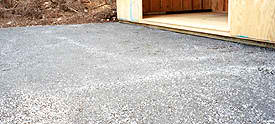
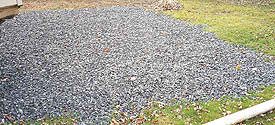
THE LEFT PHOTO depicts a tamped and rolled stone pad prepared by a professional; If done right, the pad will be dead level and almost as hard as concrete! This perfect pad was done by our local guy.
If you have any questions regarding your pad, please call us at 845-247-4449 for assistance.
To prepare a BASIC shed pad with Item-4:
- Drive stakes into all 4 corners of the building site. To be sure that the base is square, measure diagonally in both directions and check that the measurements are equal.
- From the highest ground point, mark the first stake at least 4 inches up from the base (the ground). Attach a string and string level to the 4-inch mark on the stake with a nail. Stretch out the string until level and attach it to the next stake. Continue until the string is level around all four stakes.
- Fill the area with Item-4 to the height of string lines, tamping down using a tamper or roller until it is very firm. Driveable firm…not walkable firm! Repeat this step until the entire site is level and compacted.
You can also build a box to house the Item-4 out of 4×4’s or 6×6’s. Use a level on the wood and raise/lower as needed. If you have any questions, please call us at (845) 834-3455; we’ll be happy to answer any of your questions about site preparation. If you’re local, we can recommend a professional who can do the job for you.
The recommended depth is at least 4 inches deep overall with more, as needed, in any low spots to be certain the entire surface area is level.
NOTE: All building measurements are outside and approximate. Due to highway travel; Measurements are from overhang to overhang. The actual footprint of the building may be slightly less than the purchased dimensions.
CONCRETE SLABS: This method is required for floorless structures like garages (but not animal shelters like horse barns).
Generally, a slab consists of footings that must be deep enough to go below the ‘frost line’ and at least 4″ thick of concrete. Actual specifications are dependent on your local town codes. While an Alaskan or Mono-pour slab is perfectly fine for the building; your town code may require 18″ – 48″ deep footings all around. This can vary. You are responsible for hiring a contractor who knows your local codes.
The slab should have no pitch along the first 6″ of the entire perimeter or in the center where the support walls will join. The 6×6 PT perimeter of the building should sit completely flush on the concrete. For best results; the size of the slab should be the EXACT SAME or even a hair less than the footprint of the purchased building. Keep in mind; the exact footprint will usually be less than the purchased dimensions; as our building measurements are approximate and from eave to eave due to highway travel. There should be no anchors, hooks, conduit or anything else implanted in the concrete prior to the delivery of your building. We must be able to slide the building off of the trailer and onto the pad without any obstructions. The slab should be no more than 6″ above grade; as we need to be able to drive up and on the slab during the delivery process. Blacktop foundations are not recommended! We also cannot place our buildings on raised foundation walls, cinder blocks, over basements or any other hollow center. Read more here: floorless Also, anchoring floorless structures may be customers responsibility unless otherwise arranged. We anchor all large double-wide garages as part of the job.
Anchor Referrals: informational purposes only as there are several ways to anchor a building and your local town code may require a certain procedure not listed on these sites. Be sure to inquire before making a decision.
Stone Pad anchoring: American Earth Anchors www.americanea.com or 866-520-8511
Concrete anchoring: Concrete Fastening Systems www.concretefasteners.com or 800-966-9617 (hint: look under wedge studs aka thunder studs). You may also be able to use a simple steel ‘L’ bracket attached to 6×6 and concrete floor.
FINALLY, PLEASE CALL OR EMAIL IF YOU OR YOUR CONTRACTOR HAVE ANY FOUNDATION QUESTIONS! IT’S NOT WORTH TAKING A CHANCE AND HOPING IT WILL BE RIGHT WHEN A 5 MINUTE PHONE CALL CAN RESOLVE ANY UNCERTAINTY. MANY CONTRACTORS JUST AREN’T FAMILIAR WITH THE PRE-FAB AMISH STRUCTURES, THE DELIVERY PROCESS, AND OUR SITE REQUIREMENTS. WE’VE SEEN MANY QUESTIONABLE FOUNDATIONS DONE BY SUPPOSED ‘PROFESSIONALS WITH 25 YRS IN BUSINESS’. WELL, GUESS WHAT? IT’S YOU, THE CUSTOMER, WHO’S LEFT WITH THE CHANCE OF A VOIDED WARRANTY AND A BUILDING THAT ISN’T SUPPORTED PROPERLY OVER THE LONG HAUL IF THE FOUNDATION ISN’T PROPERLY PREPARED. WHILE FIRM & DEAD LEVEL IS OBVIOUSLY BEST; WE CAN WORK WITH SLIGHT LEVEL ISSUES FOR ORDINARY SHEDS. THE LEVELNESS AND FIRMNESS BECOMES SUPER IMPORTANT FOR LARGER BUILDINGS AND ESPECIALLY FOR MODULAR BUILDINGS (OF ANY SIZE). TWO WORDS: FIRM AND LEVEL!
